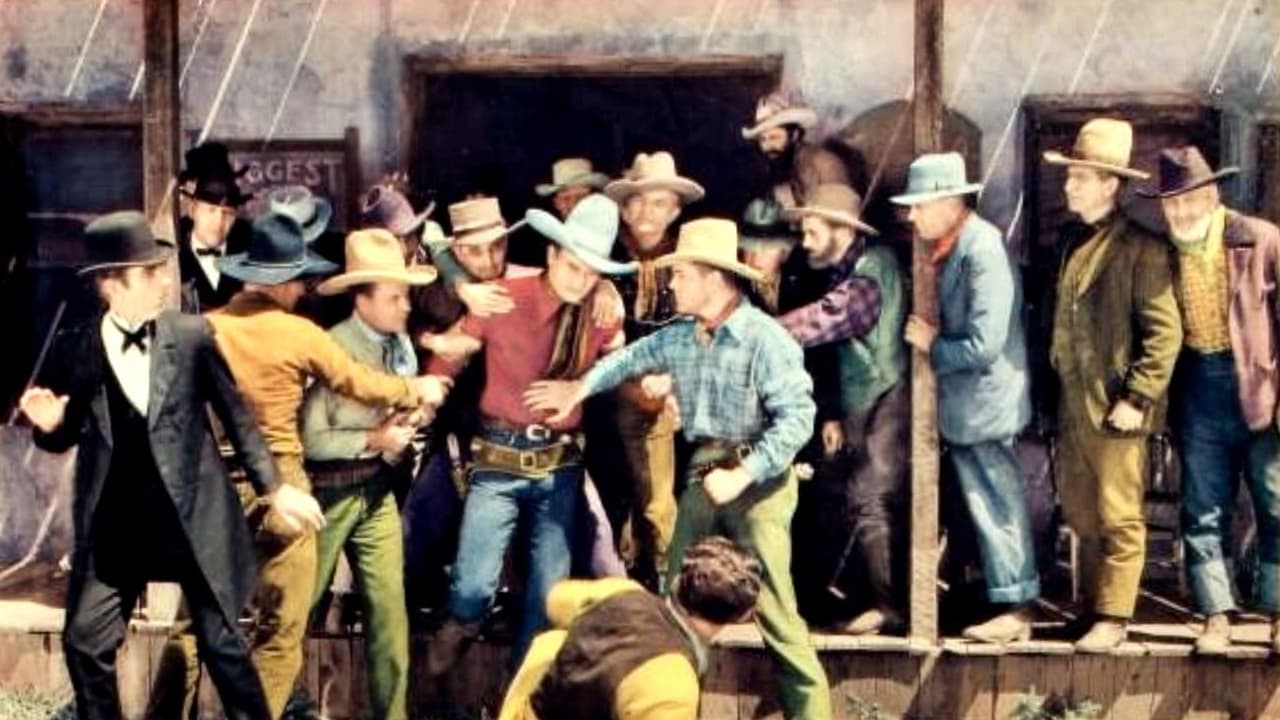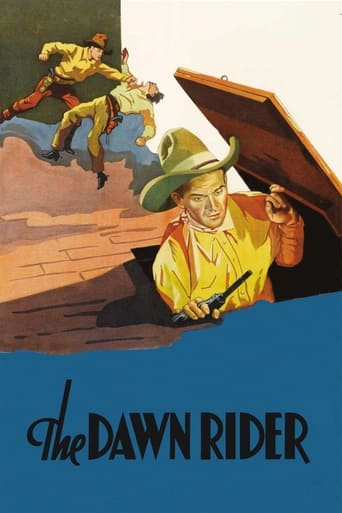

Very very predictable, including the post credit scene !!!
... View MoreWhat a waste of my time!!!
... View MoreAmateur movie with Big budget
... View MoreA Major Disappointment
... View MoreDirector: ROBERT NORTH BRADBURY. Screenplay: Robert North Bradbury. Story: Lloyd Nosler. Photography: Archie Stout. Film editor: Carl Pierson. Art director: E.R. Hickson. Sound recording: D.S. Stoner. Producer: Paul Malvern. A Lone Star Western.Not copyright by Monogram Pictures Corp. U.S. release through Republic: 20 June 1935. U.K. release through Pathé: 23 December 1935. 56 minutes;COMMENT: Plenty of action in this one. Wayne does his own riding and fighting, whilst Canutt contributes some exciting stunt-work. At the same time, the script develops its characters most interestingly, allowing Reed Howes some golden opportunities to paint a fascinating portrait of the star-crossed Ben. The villain is played most agreeably by Dennis Moore — of all people — making a nice contrast with the pleasant heroine limned by the lovely Marion Burns. It's unfortunate that action highlights are — as usual in the Monogram Lone Stars — handicapped both by the obvious absence of background music and the deployment of hollow sound effects. These defects give the picture a museum air, for which Bradbury's lively direction — complete with running inserts — manages to compensate (at least to some extent).
... View MoreThis cheapie western starring a young John Wayne starts off with a rather silly confrontation between Wayne and a local tough who just embarrassed another guy moments before. Well that wimp wasn't John Wayne, who proceeds to trash talk the tough guy before cleaning his clock. After the fight the two men become friends. Anyway, that silliness aside, the plot of the movie is about Wayne seeking his father's killer. Turns out it's his girlfriend's brother. Cue dramatic music. Or, in many modern prints, cue the crappy music made on a $20 keyboard. This is made worse by the poor audio where you have to turn the volume up to hear the dialogue, only to have sound effects or that terrible music knock you off your seat.Judged on its merits, it's not one of the better early Wayne westerns. But it does have unintentional comic value and nice photography by Archie Stout. As with most of these low-budget oaters Wayne made, the stunts are the best part. In addition to his stunt work, Yakima Canutt plays the saloon owner. This was remade in 2012 with Christian Slater. I haven't seen that one yet but I can imagine the plot is the only similarity.
... View MoreAbout the only reason to see most of John Wayne's Lone Star Westerns is because Wayne is in them. That's certainly true here, as Wayne's character seeks out the man who killed his father and gets caught up in a love triangle.Typically, Wayne's character here, John Mason, doesn't waste time. No sooner does he arrive in town than he gets into an argument with Ben McClure (Reed Howes). The two soon trade blows, followed by friendly drinks at the nearby saloon. Witnessing his father's murder changes the happy situation for Mason, though he still is in the mood for love when a woman McClure is sweet on nurses him back from a gunshot wound.This all happens in the first 15 minutes. Lone Star westerns were typically short, though this is a bit longer than most I've seen at 55 minutes. You have to allow for a rushed narrative, but this one really starves for oxygen, relying on clichés to get across story points.An opening scene features a hombre who is made to "dance" when another fellow shoots at his feet. Mason is warned to get out of town by four o'clock, or be shot on sight. Near the end of the movie, an out-of-luck cowpoke tells Mason that "it's getting' dark...Ain't sundown, is it? You oughta tell Alice I won't be home for dinner..."The dialogue here is quite goofy, and made worse by the strange voices of Wayne's supporting cast. Yakima Canutt's high, sneering register didn't get in the way of his Hollywood career as a premier stuntman, but it makes his villainous barkeep character here tough to take. Dennis Moore as chief baddie Rudd employs a basso profondo baritone, while Marion Burns as love interest Alice (Rudd's sister) uses a tremulous soprano. It's like a real horse opera when one of these two are on stage.Wayne is solid in the main role. Like other commenters here have noted, he had that short-stride, pigeon-toed walk working for him already here, and it's something to see from the opening moments when he strides into town. He demonstrates fine chemistry with the other actors, especially Howes, looking amiable and at ease (even if he should seem a bit edgier after seeing his father murdered in front of him.)There is one good bit in this film, when Mason and an associate (Lone Star regular Earl Dwire, a good player) set a trap for the bad guys and find themselves in a gun battle on a runaway wagon. It looks to be authentic; no back projection anyway, and for a few minutes the film kicks into a higher gear.But then the wagon crashes, Dwire's character is apparently dead and forgotten about, and Mason goes on with the increasingly pointless business of chasing down his father's killer. Soon we are back to Burns caterwauling about her brother's innocence, even if we know better. Why would Mason want such a woman? Why doesn't he confront her brother, instead of banter with him about his neckerchief? "The Dawn Rider" doesn't expect you to care any more than they did, and it shows.
... View MoreOne of a series of repetitious and unpretentious Westerns that Monogram put out in the 30s. They fed the public's desire for movie fare, kept actors and crew employed during the Great Depression, and were inexpensive enough to keep the studio itself sufficiently solvent to keep grinding them out. As a kind of ancillary benefit they gave John Wayne a chance to be seasoned and develop his later screen persona.He's not really the iconic John Wayne here. He's broad shouldered, trapping, tall, and athletic but his acting is rudimentary. He hadn't yet learned to express something by repressing it. His walk is still the walk of an ordinary man, although an unusually tall one.He couldn't have gotten much help from the director, Robert Bradbury, but little could have been expected, given the constraints on time and budget. It's hard to imagine that any of the scenes required more than one or two takes. There is an elemental quality to the action. Horses never walk, they always gallop, leaving clouds of dust behind them. Almost all the punches are roundhouse rights, although one does notice a few jabs, probably the contribution of Yakima Canutt. Canutt may have been the best physical actor in the Western business but isn't prominently featured in this effort.The director, Bradbury, had made a number of earlier Westerns near Lancaster, where Wayne lived, and Wayne had a chance to see the filming taking place, alongside his childhood friend, Bradbury's son, who later became known as Bob Steele. (He was Curly in "Of Mice And Men.") The movie is mostly of historical interest, though not badly done for its purposes.
... View More